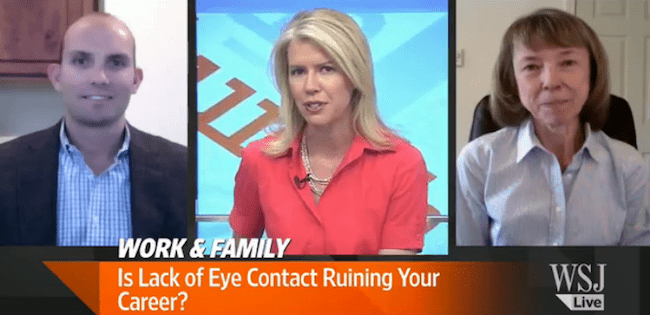“Just look me in the eye already!”
Now that’s a great title from today’s Wall Street Journal article and interview with Sue Shellenbarger. (Great exposure! At the end of the day, the eye contact piece was still ranked #1 in their “Popular Now.”)
Here’s the feature. And if you want to go right to the video interview from WSJ Lunch Break – here it is.
Summary:
Over the last 10-15 years, eye communication has plummeted. People are not looking at other people – they’re scanning an audience rather than looking at individuals, and there’s an epidemic in the great majority looking down at their smartphones when they are supposedly communicating with other people. The human connection becomes the challenge, and it all starts with the eyes. If you don’t have eye communication, you flat out don’t have communication.
Spin-off stories appeared on the WSJ blog, on the TODAY Show (here, at 4:56), and even on the Bay Area’s CBS Affiliate KPIX, where Kelly Decker discussed the role of smartphones and how we can change our habits to improve our influence (you’ll recognize our office in the clip!). You're either communicating with someone, or with something else - like your smartphone.
Lots of buzz. So what do you need to know?
Eye communication is emotional communication. Breaking eye communication (by glancing or darting away, or by looking elsewhere out of habit) breaks the connection. It signals to your listeners that you’re not interested in them, that you’re not engaged in the conversation.
During our trainings, we use several applications to enable people to see their habits. After all, how we look at people, or at our smartphones, is just a habit. We can change it. Powerful partner work and disparity exercises teach eye communication – for it is perhaps the most important of the communication skills. But the most powerful coaching technique of all is video feedback. Most people don’t know how they actually communicate with their eyes.
I have a friend who always glances away when he’s talking to someone, a scant second or less of connection, look away to the right for a few seconds, and then he comes back. (And this is just a regular conversation, no smartphone involved.) Disconcerting, to say the least. Certainly ineffective. (He did the Decker Program later and was amazed at his eye communication habits!)
On video, you can see exactly what your habits are, and how they come across to the audience. If you have poor eye communication, you can come across as untrustworthy, unknowledgeable and nervous. Knowing your habits – and working to avoid falling into your own comfortable patterns – helps you change so you can CONNECT to your audience. And the bonus that most people don’t realize: You can have control.
A Few Key Tips to Remember:
- Think 5 seconds. In a natural one-on-one situation you might go longer to 7 or even 10 seconds, then glancing away to relieve pressure. (Over 10 seconds and there may be more intimacy and emotional connection than you really want…)
- In a group setting, also think 5 seconds. It might be shorter (3 to 5 seconds), but it’s not one second or less. Eye darting is not connecting. And unfortunately most people just glance all over, moving their eyes every second or fraction. You want to look at people, at individuals. Not at space. An audience is not generic, it is a collection of individuals.
- When someone is looking at you, you are more likely to engage with what he or she is saying. We all feel more involved with someone who is connecting with the audience and talking to us, not just at us. Look back at them. And every 5-7 seconds glance away and come back to them.
- As for smartphones, become aware of your habits. Less is more. No one is connecting with you when you are checking your email – no eye communication, no communication.
There’s more, but that’s enough for this post. What are your experiences? What do you think?


Wow, great points on a topic that I don’t even think about. Eye contact is rare these days. Its actually almost startling when someone actually looks at you in the eye. What a differentiator too! Thanks for sharing 🙂